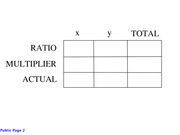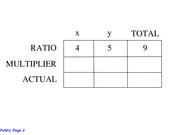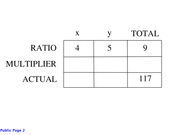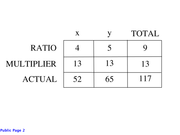The ratio of two positive numbers is 3 to 4. If k is added to each number the new ratio will be 4 to 5, and the sum of the numbers will be 117. What is the value of k?
A.) 1
B.) 13
C.) 14
D.) 18
E.) 21
Ratios problem
This topic has expert replies
-
infiniti007
- Senior | Next Rank: 100 Posts
- Posts: 37
- Joined: Wed Feb 25, 2015 6:00 pm
- Thanked: 1 times
GMAT/MBA Expert
- Brent@GMATPrepNow
- GMAT Instructor
- Posts: 16207
- Joined: Mon Dec 08, 2008 6:26 pm
- Location: Vancouver, BC
- Thanked: 5254 times
- Followed by:1268 members
- GMAT Score:770
The ratio of two positive numbers is 3 to 4.infiniti007 wrote:The ratio of two positive numbers is 3 to 4. If k is added to each number the new ratio will be 4 to 5, and the sum of the numbers will be 117. What is the value of k?
A.) 1
B.) 13
C.) 14
D.) 18
E.) 21
Let 3x = the smaller number
Let 4x = the larger number
Aside: Notice that this ensures that their ratio will equal 3/4, since 3x/4x = 3/4
If k is added to each number the new ratio will be 4 to 5 . . .
When k is added to each value, the NEW values are 3x + k and 4x + k
So, (3x + k)/(4x + k) = 4/5
Cross multiply to get: 16x + 4k = 15x + 5k
Rearrange terms to get: x = k
. . . and the sum of the numbers will be 117
The two NEW values are 3x + k and 4x + k
So, we can write: (3x + k) + (4x + k) = 117
Simplify to get 7x + 2k = 117
Since x = k, we can take the above equation and replace x with k to get...
7k + 2k = 117
Simplify: 9k = 117
Solve: k = 13
Answer: A
Cheers,
Brent
- GMATGuruNY
- GMAT Instructor
- Posts: 15539
- Joined: Tue May 25, 2010 12:04 pm
- Location: New York, NY
- Thanked: 13060 times
- Followed by:1906 members
- GMAT Score:790
The problem above is the same as the following:
To determine the values of x and y, use a RATIO BOX:

Since x:y = 4:5, the total for the ratio is 9:

Since the actual total of x and y is 117, we get:

Since (actual total)/(ratio total) = 117/9 = 13, the multiplier for the box is 13, as follows:

Thus, x = 52 and y = 65.
From here, we can PLUG IN THE ANSWERS for the value of k.
When the correct value is subtracted from x and y, the resulting ratio will be 3 to 4.
Answer choice A: k=1
(52-1)/(65-1) = 51/64.
Eliminate A.
Answer choice B: k=13
(52-13)/(65-13) = 39/52 = 3/4.
Success!
The correct answer is B.
Let x = the smaller number and y = the larger number.The ratio of two positive numbers is 4 to 5, and the sum of the two numbers is 117. If k is SUBTRACTED FROM each number, the new ratio will be 3 to 4. What is the value of k?
1
13
14
18
21
To determine the values of x and y, use a RATIO BOX:

Since x:y = 4:5, the total for the ratio is 9:

Since the actual total of x and y is 117, we get:

Since (actual total)/(ratio total) = 117/9 = 13, the multiplier for the box is 13, as follows:

Thus, x = 52 and y = 65.
From here, we can PLUG IN THE ANSWERS for the value of k.
When the correct value is subtracted from x and y, the resulting ratio will be 3 to 4.
Answer choice A: k=1
(52-1)/(65-1) = 51/64.
Eliminate A.
Answer choice B: k=13
(52-13)/(65-13) = 39/52 = 3/4.
Success!
The correct answer is B.
Private tutor exclusively for the GMAT and GRE, with over 20 years of experience.
Followed here and elsewhere by over 1900 test-takers.
I have worked with students based in the US, Australia, Taiwan, China, Tajikistan, Kuwait, Saudi Arabia -- a long list of countries.
My students have been admitted to HBS, CBS, Tuck, Yale, Stern, Fuqua -- a long list of top programs.
As a tutor, I don't simply teach you how I would approach problems.
I unlock the best way for YOU to solve problems.
For more information, please email me (Mitch Hunt) at [email protected].
Student Review #1
Student Review #2
Student Review #3
Followed here and elsewhere by over 1900 test-takers.
I have worked with students based in the US, Australia, Taiwan, China, Tajikistan, Kuwait, Saudi Arabia -- a long list of countries.
My students have been admitted to HBS, CBS, Tuck, Yale, Stern, Fuqua -- a long list of top programs.
As a tutor, I don't simply teach you how I would approach problems.
I unlock the best way for YOU to solve problems.
For more information, please email me (Mitch Hunt) at [email protected].
Student Review #1
Student Review #2
Student Review #3
hi allinfiniti007 wrote:The ratio of two positive numbers is 3 to 4. If k is added to each number the new ratio will be 4 to 5, and the sum of the numbers will be 117. What is the value of k?
A.) 1
B.) 13
C.) 14
D.) 18
E.) 21
is my way correct?
K/k add to 3/4 to get 5/4 and sum of the 4/5's numerator and denominator must be 117.then K can be any no. but resulted ratio parts must be sum up to 117. so we just add ratio parts to get 4+5=9 then 117/9=13 answer "B" is correct.
thanks
- OptimusPrep
- Master | Next Rank: 500 Posts
- Posts: 410
- Joined: Fri Mar 13, 2015 3:36 am
- Location: Worldwide
- Thanked: 120 times
- Followed by:8 members
- GMAT Score:770
Hi Pazoki,Pazoki wrote:hi allinfiniti007 wrote:The ratio of two positive numbers is 3 to 4. If k is added to each number the new ratio will be 4 to 5, and the sum of the numbers will be 117. What is the value of k?
A.) 1
B.) 13
C.) 14
D.) 18
E.) 21
is my way correct?
K/k add to 3/4 to get 5/4 and sum of the 4/5's numerator and denominator must be 117.then K can be any no. but resulted ratio parts must be sum up to 117. so we just add ratio parts to get 4+5=9 then 117/9=13 answer "B" is correct.
thanks
If you add k/k to 3/4, it means that you are adding 1 to 3/4
Whereas the question says to add k to each of numerator and denominator.
Assuming the numbers to be 3x and 4x.
We are given that (3x + k) / (4x + k) = 4/5
Does this help?
-
Matt@VeritasPrep
- GMAT Instructor
- Posts: 2630
- Joined: Wed Sep 12, 2012 3:32 pm
- Location: East Bay all the way
- Thanked: 625 times
- Followed by:119 members
- GMAT Score:780
This is a clever idea, but you're assuming here that number means integer, and that each piece of the ratio must be a factor of 117. If we make that assumption, we don't even need to bother with the other steps, we can just say 4n + 5n = 117, and n = 13. If we DON'T make that assumption, then we have to actually solve.Pazoki wrote:hi allinfiniti007 wrote:The ratio of two positive numbers is 3 to 4. If k is added to each number the new ratio will be 4 to 5, and the sum of the numbers will be 117. What is the value of k?
A.) 1
B.) 13
C.) 14
D.) 18
E.) 21
is my way correct?
K/k add to 3/4 to get 5/4 and sum of the 4/5's numerator and denominator must be 117.then K can be any no. but resulted ratio parts must be sum up to 117. so we just add ratio parts to get 4+5=9 then 117/9=13 answer "B" is correct.
thanks
GMAT/MBA Expert
- Brent@GMATPrepNow
- GMAT Instructor
- Posts: 16207
- Joined: Mon Dec 08, 2008 6:26 pm
- Location: Vancouver, BC
- Thanked: 5254 times
- Followed by:1268 members
- GMAT Score:770
The ratio of two positive numbers is 3 to 4.infiniti007 wrote:The ratio of two positive numbers is 3 to 4. If k is added to each number the new ratio will be 4 to 5, and the sum of the numbers will be 117. What is the value of k?
A.) 1
B.) 13
C.) 14
D.) 18
E.) 21
Let 3x = the smaller number
Let 4x = the larger number
Aside: Notice that this ensures that their ratio will equal 3/4, since 3x/4x = 3/4
If k is added to each number the new ratio will be 4 to 5 . . .
When k is added to each value, the NEW values are 3x + k and 4x + k
So, (3x + k)/(4x + k) = 4/5
Cross multiply to get: 16x + 4k = 15x + 5k
Rearrange terms to get: x = k
. . . and the sum of the numbers will be 117
The two NEW values are 3x + k and 4x + k
So, we can write: (3x + k) + (4x + k) = 117
Simplify to get 7x + 2k = 117
Since x = k , we can take the above equation and replace x with k to get...
7k + 2k = 117
Simplify: 9k = 117
Solve: k = 13
Answer: B
Cheers,
Brent
GMAT/MBA Expert
- Scott@TargetTestPrep
- GMAT Instructor
- Posts: 7240
- Joined: Sat Apr 25, 2015 10:56 am
- Location: Los Angeles, CA
- Thanked: 43 times
- Followed by:29 members
Since the ratio of the numbers is 3 to 4, the two numbers can be expressed as 3x and 4x for some positive value x.infiniti007 wrote:The ratio of two positive numbers is 3 to 4. If k is added to each number the new ratio will be 4 to 5, and the sum of the numbers will be 117. What is the value of k?
A.) 1
B.) 13
C.) 14
D.) 18
E.) 21
Since the ratio after k is added to each number is 4 to 5, we can create the following equation:
(3x + k)/(4x + k) = 4/5
15x + 5k = 16x + 4k
k = x
Since the sum of the two numbers after adding k to each of them is 117, we have:
(3x + k) + (4x + k) = 117
(3x + x) + (4x + x) = 117
9x = 117
x = 13
Thus, k = x = 13.
Answer: B
Scott Woodbury-Stewart
Founder and CEO
[email protected]

See why Target Test Prep is rated 5 out of 5 stars on BEAT the GMAT. Read our reviews






















